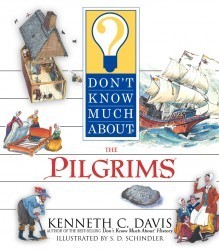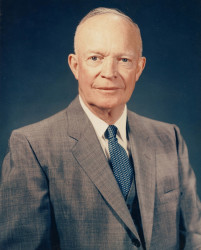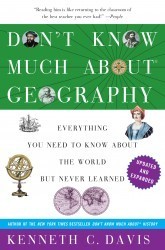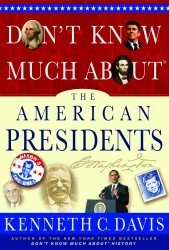Kenneth C. Davis's Blog, page 91
December 5, 2013
Don’t Know Much About® Van Buren

President Martin Van Buren (Photo Courtesy of Library of Congress)
OK –Literally. Martin Van Buren, the eighth President of the United States, was born on December 5, 1782 in Kinderhook, New York, making him the first American president born a U.S. citizen. Van Buren was also known as “Old Kinderhook, or “OK,” the origin of that American expression.
If you haven’t figured it out by now, he is also the answer to this week’s Who Said It Quiz
The last, perhaps the greatest, of the prominent sources of discord and disaster supposed to lurk in our political condition was the institution of domestic slavery. ..”I must go into the Presidential chair the inflexible and uncompromising opponent of every attempt on the part of Congress to abolish slavery in the District of Columbia against the wishes of the slaveholding States, and also with a determination equally decided to resist the slightest interference with it in the States where it exists.”
Martin van Buren: “Inaugural Address,” March 4, 1837. Online by Gerhard Peters and John T. Woolley, The American Presidency Project. http://www.presidency.ucsb.edu/ws/?pi....
The first New Yorker elected President, Van Buren was a political power broker who mastered the art of “machine politics” and helped bring New York into Andrew Jackson’s column in 1828. He became Jackson’s Secretary of State and later his vice president. He won the presidential election of 1836. But his presidency was tainted by the Panic of 1837, a deep economic depression that lasted seven years. He was defeated in 1840 by William Henry Harrison of the Whig Party.
Fast Facts:
•Van Buren was the first president not of English descent. Growing up in a Dutch-speaking household, he was also the only president who spoke English as a second language.
•As a young attorney, he became the protege of Aaron Burr. Due to a passing resemblance and their political and professional connections, it was rumored that he was Burr’s son, gossip thoroughly dismissed by historians.
•Elected Governor of New York in November 1828, Van Buren took the office on January 1, 1829 but resigned on March 12, 1829 to become secretary of state, making him the shortest tenured governor in New York history.
•During Van Buren’s administration, the removal of native Americans from the Southeast accelerated including the removal of the Cherokee on the “Trail of Tears.”
•The Congressional “gag rule” was passed during his presidency; the rule forbid any discussion of petitions relating to slavery, including banning slavery in Washington, D.C, as mentioned in Van Buren’s inaugural address above.
•Failing to win the Democratic nomination in 1844, Van Buren became the first president to run on a third party ticket when he joined the Free Soil Party as its candidate in 1848.
You can read more about his life at the Martin Van Buren Historical Site (National Parks Service)
And read more about Van Buren and his administration in Don’t Know Much About® the American Presidents

Don’t Know Much About the American Presidents (2012)
(From Hyperion and Random House Audio)
December 1, 2013
Who Said It? (12/1/2013)

OK –Literally. Martin Van Buren, the eighth President of the United States, was born on December 5, 1782 in Kinderhook, New York, making him the first American president born a U.S. citizen. Van Buren was also known as “Old Kinderhook, or “OK,” the origin of that American expression.
The last, perhaps the greatest, of the prominent sources of discord and disaster supposed to lurk in our political condition was the institution of domestic slavery. ..”I must go into the Presidential chair the inflexible and uncompromising opponent of every attempt on the part of Congress to abolish slavery in the District of Columbia against the wishes of the slaveholding States, and also with a determination equally decided to resist the slightest interference with it in the States where it exists.”
Martin van Buren: “Inaugural Address,” March 4, 1837. Online by Gerhard Peters and John T. Woolley, The American Presidency Project. http://www.presidency.ucsb.edu/ws/?pi....
Read more about Martin Van Buren in this post.
Who Said It? (12/1/13)

President Martin Van Buren (Photo Courtesy of Library of Congress)
Martin Van Buren, 8th President of the United States: Inaugural Address (March 4, 1837)
The last, perhaps the greatest, of the prominent sources of discord and disaster supposed to lurk in our political condition was the institution of domestic slavery. ..”I must go into the Presidential chair the inflexible and uncompromising opponent of every attempt on the part of Congress to abolish slavery in the District of Columbia against the wishes of the slaveholding States, and also with a determination equally decided to resist the slightest interference with it in the States where it exists.”
Martin van Buren: “Inaugural Address,” March 4, 1837. Online by Gerhard Peters and John T. Woolley, The American Presidency Project. http://www.presidency.ucsb.edu/ws/?pi....
Martin Van Buren. the 8th President, was born on December 5, 1782 in Kinderhook, N.Y.
Martin Van Buren Historical Site (National Parks Service)
Read more about Van Buren and his administration on Don’t Know Much About® the American Presidents

Don’t Know Much About the American Presidents (2012)
(From Hyperion and Random House Audio)
November 27, 2013
Don’t Know Much About® the Real First Pilgrims
Always a good time to remember the “Real First Pilgrims”
As we cut through the myth and misconception surrounding the “first Thanksgiving,” it is easy to say that there was nothing new or novel about the October 1621 “harvest feast” celebrated in Massachusetts by the surviving Mayflower passengers. Certainly harvest festivals go back to the dawn of time. And in America, such “thanksgiving days” were surely celebrated by the Spanish in the Southwest and Englishmen in Virginia well before the Mayflower sailed.
But one group has been left out of the picture completely. And their story deserves to be part of the Thanksgiving conversation. They were French and had the good sense to settle in Florida in June instead of Massachusetts in December. They reached the future America in 1564, long before the Mayflower arrived in December 1620 carrying those “Pilgrims.” Like the storied English Separatists, these French Protestants, or Huguenots, came to America seeking religious freedom in the midst of France’s bloody religious civil wars. But they have been overlooked by most history books. Their plight — and tragic fate– is the subject of an article I wrote for the New York Times.
TO commemorate the arrival of the first pilgrims to America’s shores, a June date would be far more appropriate, accompanied perhaps by coq au vin and a nice Bordeaux. After all, the first European arrivals seeking religious freedom in the “New World” were French. And they beat their English counterparts by 50 years. That French settlers bested the Mayflower Pilgrims may surprise Americans raised on our foundational myth, but the record is clear.
Here you can read the rest of this Op-Ed, A French Connection which first appeared in the New York Times on November 25, 2008.
[image error]
New York Times Bestseller America’s Hidden History
The complete story of the French Huguenots who settled Fort Caroline in Florida is told in the first chapter of America’s Hidden History.
You can also learn more about the “first Pilgrims” at the Fort Caroline and Fort Matanzas National Park Service sites.
November 26, 2013
Thanksgiving Pop Quiz- A Videoblog
With Thanksgiving around the corner, cutouts of Pilgrims in black clothes and clunky shoes are sprouting all over the place. You may know that the Pilgrims sailed aboard the Mayflower and arrived in Plymouth, Massachusetts in 1620. But did you know their first Thanksgiving celebration lasted three whole days? What else do you know about these early settlers of America? Don’t be a turkey. Try this True-False quiz.
True or False? (Answers below)
1. Pilgrims always wore stiff black clothes and shoes with silver buckles.
2. The Pilgrims came to America in search of religious freedom.
3. Everyone on the Mayflower was a Pilgrim.
4. The Pilgrims were saved from starvation by a native American friend named Squanto.
5. The Pilgrims celebrated the first Thanksgiving in America.
Read more about the Mayflower and its passengers with your children in Don’t Know Much About the Pilgrims.

Don’t Know Much About® the Pilgrims
And read about America’s real “first Pilgrims”–French Huguenots who landed in Florida more than fifty years before the Mayflower sailed– in America’s Hidden History
The site of Plimouth Plantation is definitely worth a visit.
Answers
1. False. Pilgrims wore blue, green, purple and brownish clothing for everyday. Those who had good black clothes saved them for the Sabbath. No Pilgrims had buckles– artists made that up later!
2. True. The Pilgrims were a group of radical Puritans who had broken away from the Church of England. After 11 years of “exile” in Holland, they decided to come to America.
3. False. Only about half of the 102 people on the Mayflower were what William Bradford later called “Pilgrims.” The others, called “Strangers” just wanted to come to the New World.
4. True. Squanto, or Tisquantum, helped teach the Pilgrims to hunt, farm and fish. He learned English after being taken as a slave aboard an English ship.
5. False. The Indians had been having similar harvest feasts for years. So did the English settlers in Virginia and Spanish settlers in the southwest before the Pilgrims even got to America. And the Mayflower Pilgrims weren’t even America’s “first Pilgrims.” That honor goes to French Huguenots who settled in Florida more than 50 years before the Mayflower sailed.

Don’t Know Much About History (Revised, Expanded and Updated Edition)
October 3, 2013
Who Said It” (10/3/2013)
President Abraham Lincoln, “Proclamation of Thanksgiving” (October 3, 1863)
And I recommend to them that while offering up the ascriptions justly due to Him for such singular deliverances and blessings, they do also, with humble penitence for our national perverseness and disobedience, commend to His tender care all those who have become widows, orphans, mourners or sufferers in the lamentable civil strife in which we are unavoidably engaged, and fervently implore the interposition of the Almighty Hand to heal the wounds of the nation and to restore it as soon as may be consistent with the Divine purposes to the full enjoyment of peace, harmony, tranquility and Union.
Announced 150 years ago on October 3, 1863, this presidential proclamation, widely believed to be written by Secretary of State William Seward, established the precedent for the first American national Thanksgiving Day.
September 27, 2013
Banned Books Week (2013): “Don’t Join the Book Burners”
(This video was made in 2010 but I re-post it for Banned Books Week)
To close out the 2013 edition of Banned Books Week, I offer the words of President Dwight D. Eisenhower in a commencement address delivered at Dartmouth in 1953:
Don’t join the book burners. Don’t think you are going to conceal faults by concealing evidence that they ever existed. Don’t be afraid to go in your library and read every book, as long as that document does not offend our own ideas of decency. That should be the only censorship.
–President Dwight D. Eisenhower, “Remarks at Dartmouth College Commencement (June 14, 1953)

President Eisenhower (Courtesy: Eisenhower Presidential Library and Museum)
(Source: Dwight D. Eisenhower: “Remarks at the Dartmouth College Commencement Exercises, Hanover, New Hampshire.,” June 14, 1953. Online by Gerhard Peters and John T. Woolley, The American Presidency Project. http://www.presidency.ucsb.edu/ws/?pi....)
While books are rarely actually “banned” in America, the concept of restricting access to some books is much more commonplace, usually in classrooms and school libraries. Typically , books are pulled from shelves and reading lists after the objection of a an individual or group. The American Library Association, which sponsors “Banned Books Week,” explains the difference between “banned” and “challenged.”
A challenge is an attempt to remove or restrict materials, based upon the objections of a person or group. A banning is the removal of those materials. Challenges do not simply involve a person expressing a point of view; rather, they are an attempt to remove material from the curriculum or library, thereby restricting the access of others. Due to the commitment of librarians, teachers, parents, students and other concerned citizens, most challenges are unsuccessful and most materials are retained in the school curriculum or library collection.
As the nation debates “Common Core,” an educational approach that demands reading and responding to ideas, the importance of this reminder of the right to free expression and the value of THINKING in a free society is more urgent than ever.
You can find many more resources on the issue of “banned” and “challenged” books at the American Library Association.
The New York Times Learning Network also offers some good teaching resources on classroom discussion of “controversial” books.
September 25, 2013
“Don’t Join the Book Burners”-Banned Books Week (2013)
(This video was made in 2010 but I re-post it for Banned Books Week)
Don’t join the book burners. Don’t think you are going to conceal faults by concealing evidence that they ever existed. Don’t be afraid to go in your library and read every book, as long as that document does not offend our own ideas of decency. That should be the only censorship.
–President Dwight D. Eisenhower, “Remarks at Dartmouth College Commencement (June 14, 1953)
(Source: Dwight D. Eisenhower: “Remarks at the Dartmouth College Commencement Exercises, Hanover, New Hampshire.,” June 14, 1953. Online by Gerhard Peters and John T. Woolley, The American Presidency Project. http://www.presidency.ucsb.edu/ws/?pi....)
This week from September 22-28, ,2013, the nation’s libraries mark Banned Books Week.
Rarely are books actually “banned” in America. More typically , they are pulled from libraries and classrooms after the objection of a an individual or group. The ALA explains the difference between “banned” and “challenged.”
A challenge is an attempt to remove or restrict materials, based upon the objections of a person or group. A banning is the removal of those materials. Challenges do not simply involve a person expressing a point of view; rather, they are an attempt to remove material from the curriculum or library, thereby restricting the access of others. Due to the commitment of librarians, teachers, parents, students and other concerned citizens, most challenges are unsuccessful and most materials are retained in the school curriculum or library collection.
So it is time to think about the “Book Wars” again. That often means rounding up the “usual suspects” like The Catcher in the Rye, Beloved, or To Kill a Mockingbird.
But it also means that new books come along all the time that many parents, school board members or other individuals find “offensive” or “inappropriate.”
As the nation debates “Common Core,” an educational approach that demands reading and responding to ideas, the importance of this reminder of the right to free expression and the value of THINKING in a free society is more urgent than ever.
You can find many more resources on the issue of “banned” and “challenged” books at the American Library Association.
September 24, 2013
“The World is a Pear”-Classroom Skype with Author Kenneth C. Davis

Don’t Know Much About® Geography (Revised & Updated from HarperCollins and Random House Audio)
Columbus Day is Monday October 14–Geography Awareness Week is NOVEMBER 17-23
Dear Teachers,
In a world of Google Maps, FourSquare, GPS and “Checking In” on smartphones- who needs Geography?
Of course, we all do. Geography isn’t just about dots on a map or a turn-by-turn list of driving directions. Geography is about asking questions, being curious about the world, and understanding that where things happen has everything to do with why they happen.
Tying in with Columbus Day on October 14, as well as with the release of the newly revised and updated edition of Don’t Know Much About Geography (Harper Collins and Random House Audio), bring author Kenneth C. Davis into your classroom to discuss the joys of Geography with your students as he poses and ponders such questions as:
*Why did Columbus think the world was shaped like a pear?
*What can you build with BRICS?
*Does the World Bank have ATMs?
*Is all the talk of global warming just hot air?
*And, that old standard, how many oceans are there? (Hint: More than before.)
Davis will discuss the central role geography plays in history, literature, world economics and religion –and all the other subjects we “need to know.”
He will do so in a LIMITED number of free SKYPE sessions offered to middle school and high school geography and social studies classes, based on his availability.
Each session will last about 30 to 45 minutes and include time for students to ask questions.
To inquire about booking a session, please go to this website’s Contact page
Be sure to include the name and full address of your school along with any school or class website if applicable.
These sessions will be offered from mid-October through Geography Awareness Week (Nov. 17-23), to a limited number of classes, subject to the author’s availability.
You can listen to an audio sample from Don’t Know Much About Geography here.
And remember, what you don’t know can be thrilling!
Who Said It? (9/24/13)

President Eisenhower (Courtesy: Eisenhower Presidential Library and Museum)
President Dwight D. Eisenhower Address to the Nation on the Little Rock Integration Crisis (September 24, 1957)
Following the decision to desegregate public schools (Brown v Board of Education, 1954), there was widespread resistance to the orders. In 1957, the integration crisis came to a head in Little Rock, Arkansas, where Governor Orval Faubus challenged efforts by the school board to institute a gradual school desegregation process. He ordered state National Guard troops to defy Federal law and stop nine African-American students from attending an all-white high school.
Images of the subsequent mob violence directed towards the “Little Rock Nine” were seen around the world. In response, President Dwight D. Eisenhower, on September 24, 1957, announced he would send in federal troops to defend the court ruling and protect the children.
“In that city, under the leadership of demagogic extremists, disorderly mobs have deliberately prevented the carrying out of proper orders from a Federal Court. Local authorities have not eliminated that violent opposition and, under the law, I yesterday issued a Proclamation calling upon the mob to disperse.
This morning the mob again gathered in front of the Central High School of Little Rock, obviously for the purpose of again preventing the carrying out of the Court’s order relating to the admission of Negro children to that school.
Whenever normal agencies prove inadequate to the task and it becomes necessary for the Executive Branch of the Federal Government to use its powers and authority to uphold Federal Courts, the President’s responsibility is inescapable. In accordance with that responsibility, I have today issued an Executive Order directing the use of troops under Federal authority to aid in the execution of Federal law at Little Rock, Arkansas. This became necessary when my Proclamation of yesterday was not observed, and the obstruction of justice still continues.
….The interest of the nation in the proper fulfillment of the law’s requirements cannot yield to opposition and demonstrations by some few persons.
Mob rule cannot be allowed to override the decisions of our courts.”
Source: Eisenhower Presidential Library
Although the nine students enrolled, resistance to desegregation continued as Faubus closed Little Rock high schools the following year and the number of desegregated schools in the South dropped precipitously in the ensuing years.
Eisenhower later described this as the toughest decision he had made since D-Day. Senator Richard Russell of Georgia, usually an Ike supporter and powerful head of the Senate Armed Forces Committee, protested what he called:
“the high-handed and illegal methods being employed by the armed forces of the United States… who are carrying out your orders to mix the races in the public schools… by applying tactics which must have been copied from the manual issued [to] the officers of Hitler’s storm troopers.”
Source: Jean Edward Smith, Eisenhower in War and Peace, pp. 716-727
The video of Eisenhower’s televised speech is available at C-Span Video Library. Transcript of address
More material on the crisis can be found at the Eisenhower Presidential Library archive.
Read more about Eisenhower, his administration and the Little Rock crisis in these books.

Don’t Know Much About® the American Presidents-now available in hardcover and eBook and audiobook

Don’t Know Much About History (Revised, Expanded and Updated Edition)



